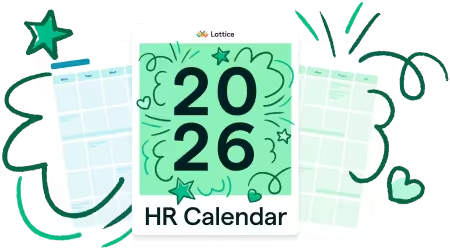Company Slack Guide Policy Template


Download this template for free
By submitting your information, you agree to Lattice's Terms of Service and Privacy Policy. You can opt out anytime.
Thanks! We'll be in touch soon.
Slack has quickly become one of the most widely adopted tools for internal communication, especially for hybrid and remote teams. Its real-time messaging, channel-based organization, and integrations with tools like Google Drive, Zoom, and Lattice make it a powerful hub for team collaboration.
But without clear expectations, Slack can also become overwhelming — or worse, a distraction. A Slack guide policy helps define best practices around communication etiquette, responsiveness, and when to take a conversation elsewhere. Whether your company is rolling out Slack for the first time or needs to reinforce norms for a growing team, a policy like this can help employees use the tool more effectively and respectfully.
What the Slack Guide Policy Should Include
To be most effective, your Slack policy should include:
- Purpose of Slack: What it's meant for (and not meant for) within your organization.
- Expected etiquette: Tone, formatting, and behavior expectations for how employees communicate.
- Channel guidelines: Naming conventions, public vs. private channel use, and which conversations belong where.
- DM usage: When it’s okay to use direct messages versus public channels.
- Working hours and response time expectations: When people are expected to be online and whether messages need to be answered in real time.
- Notification boundaries: Guidance on using @mentions and reducing notification overload.
- File sharing and integrations: Rules around uploading files, using Slack integrations, and connecting external apps.
- Security and data retention: Guidelines for sensitive info and what’s appropriate to share in Slack.
- Code of conduct reinforcement: Slack is a workplace tool, and messages should follow all HR and behavioral policies.
- Admin and moderation: Who oversees Slack usage, sets permissions, or intervenes in misuse.
Purpose of the Slack Policy
The goal of this Slack policy is to help employees communicate clearly, respectfully, and efficiently — without causing burnout or distractions. It’s designed to make sure Slack supports productivity, encourages transparency, and aligns with the company’s broader values and behavioral expectations.
By setting guidelines upfront, companies can:
- Reduce misunderstandings about response time or message urgency.
- Help new hires ramp up faster.
- Prevent tool misuse or security risks.
- Foster an inclusive and collaborative communication culture.
Sample Slack Guide Policy
{{rich-highlight-1}}
Effective Date: [Insert Date]
Policy Owner: People Team
Last Reviewed: [Insert Date]
1. Purpose and Scope
Slack is [Company Name]’s primary tool for internal messaging. It’s intended to support fast, transparent communication between individuals, teams, and the broader organization.
This policy applies to all employees, contractors, and interns who use Slack as part of their work. It’s meant to guide how we communicate with each other in a way that’s aligned with our values: respectful, thoughtful, and inclusive.
2. Slack Is for Work Communication
Slack should primarily be used for work-related conversations. Casual social chats are welcome — and even encouraged — in designated channels (like #random or #social), but Slack is not a private messaging app.
Examples of appropriate Slack use:
- Collaborating on projects or deliverables.
- Asking team members for updates or support.
- Sharing relevant company or industry news.
- Coordinating meetings or daily logistics.
- Giving kudos or celebrating wins.
Avoid using Slack for:
- Sharing confidential HR, legal, or customer information unless in a secure, approved channel.
- Personal disputes or conversations better suited to other formats (e.g., email or one-on-ones).
- Spamming channels with irrelevant or excessive messages.
3. Channel Guidelines
Slack channels help keep conversations organized and discoverable. To that end:
- Public channels should be used by default. These promote transparency and allow other team members to search and learn from previous conversations.
- Private channels are acceptable for sensitive topics, such as people team discussions or confidential project work.
- DMs (direct messages) should be used sparingly. When you’re collaborating on something with more than two people, move the conversation into a public channel or group chat.
Follow the company’s naming conventions to keep things clear and searchable:
#team-[function](e.g., #team-marketing)#proj-[initiative](e.g., #proj-website-redesign)#help-[tool](e.g., #help-zoom, #help-payroll)
4. Slack Etiquette
Clear, thoughtful messaging helps everyone stay productive. Here are our expectations:
- Use threads to keep conversations organized.
- Use emoji reactions to acknowledge messages when a reply isn’t necessary.
- Be concise. If something takes more than a few paragraphs to explain, consider a Zoom or one-on-one instead.
- Assume positive intent. Without tone or facial expressions, messages can be misread. Default to generosity.
- Respect time zones. Use scheduled messages when appropriate or consider async tools for complex discussions.
- Limit @channel and @here mentions to urgent or time-sensitive announcements.
- Avoid “just following up” DMs. If someone hasn’t responded, consider nudging them respectfully in a thread or email instead.
{{rich-highlight-3}}
5. Working Hours and Response Expectations
Slack is not meant to create an “always-on” culture. Here’s what to expect:
- Employees are not expected to respond outside of standard working hours unless pre-agreed or on-call.
- Use your Slack status (e.g., 🏝 OOO, ☕ Focus Time) to communicate availability.
- If a message is truly urgent, clearly state that — and consider sending an email or calling if needed.
Managers should model healthy boundaries and avoid sending messages at off hours unless it’s time-sensitive.
6. File Sharing and Integrations
You can share files like PDFs, images, and documents via Slack, but always double-check for sensitive data before uploading. For collaborative documents, link to Google Drive or another approved cloud storage solution to ensure version control.
We allow integrations with tools like:
- Google Workspace (Docs, Calendar, etc.)
- Zoom
- Lattice
- Jira
- Asana
Employees should not install or authorize third-party Slack apps without approval from IT or the People Team.
7. Security and Conduct
Slack is an official company platform — meaning all messages may be subject to audit or retrieval if needed for legal or internal investigations. Keep that in mind before hitting “Send.”
The company’s [Code of Conduct], [Acceptable Use Policy], and [Anti-Harassment Policy] apply to Slack just as they do to email, meetings, and other workplace environments.
Unacceptable use includes:
- Harassment, bullying, or discrimination.
- Sharing confidential or proprietary information in public channels.
- Creating or using inappropriate channel names or usernames.
- Posting misleading or offensive content.
Slack is not anonymous, and actions on the platform are traceable to your company account.
8. Admin Access and Reporting
Slack admins are responsible for:
- Creating and archiving channels.
- Managing integrations and app permissions.
- Handling reports of inappropriate behavior.
To report a Slack issue — such as inappropriate messages or channels — contact [Insert contact info or form link] or notify your manager or People Partner.
Frequently Asked Questions
Can I turn off Slack notifications after hours?
Yes — and we encourage it! Use Slack’s notification settings or Do Not Disturb mode to protect your off time. You can also schedule messages to send later if needed.
Is it okay to use Slack for casual conversation?
Absolutely — in moderation and in the right place. Use social channels like #random or #fun to build connection without disrupting work-focused channels.
Can I share confidential client documents in Slack?
Only in approved private channels — and only if the information does not violate any client agreements or internal confidentiality rules. When in doubt, check with Legal or your manager.
What if someone sends me an inappropriate message?
Please report it immediately to the People Team or your manager. We take inappropriate behavior seriously, and Slack is subject to the same policies as any other workplace setting.
Are my Slack messages private?
Slack messages are stored on [Company Name]’s systems and may be accessed by admins if needed for compliance, legal review, or workplace investigations. Treat Slack like any other work platform — with professionalism.
{{rich-highlight-2}}
🚩 Please note: This sample policy is for informational purposes only and does not constitute legal advice. It is a generic template that may not suit your specific circumstances. When adopting or revising a policy, consult legal counsel to ensure compliance with all applicable laws and regulations.
✨ Disclaimer: This resource was developed with the help of artificial intelligence, though reviewed, edited, and approved by (real) humans.
Frequently Asked Questions

Your people are your business
Ensure both are successful with Lattice.





.webp)